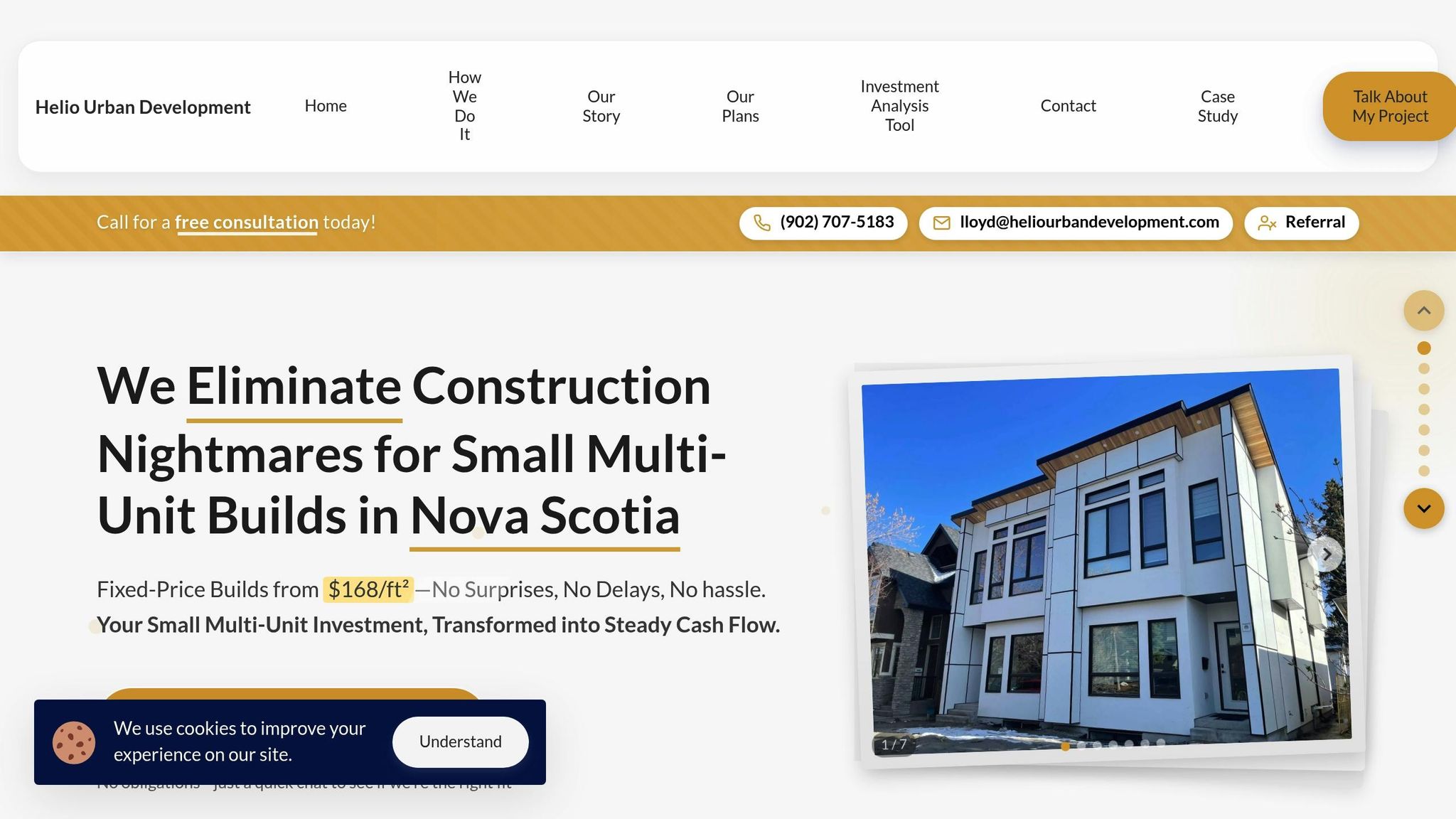The Nova Scotia Accessibility Act (NSAA) is a law designed to ensure buildings and spaces in Nova Scotia are accessible to everyone, including individuals with disabilities. Developers must follow specific standards for new construction and major renovations to comply with this Act. Here's what you need to know:
-
Who Needs to Comply?
Applies to new buildings and significant renovations, including commercial spaces, multi-unit housing, and public facilities. -
Key Requirements:
- Barrier-free entrances
- Ramps with handrails
- Clear, accessible signage
-
Why It Matters:
- Avoid legal penalties, stop-work orders, and fines.
- Accessible properties often attract higher valuations and broader tenant appeal.
-
How to Stay Compliant:
- Conduct site assessments early.
- Work with accessibility consultants and design professionals.
- Keep detailed compliance records to simplify inspections.
Ignoring these rules can lead to costly retrofits or project delays. By planning accessibility features from the start, developers can save money and meet legal requirements.
Information about the Built Environment Accessibility Standard
Built Environment Standards
The Nova Scotia Accessibility Act outlines guidelines to create buildings that are easier for everyone to use. These rules focus on ensuring that new buildings and major renovations include design elements that improve access for all.
Where Standards Apply
These standards apply to new buildings and significant renovations. They cover a range of spaces, including commercial buildings, multi-unit housing, public facilities, and shared areas. The goal is to ensure accessible design is built into these spaces from the start.
Key Features
Some of the most common features include:
- Barrier-free entrances
- Well-designed ramps with handrails
- Clear, easy-to-read signage
These elements work together to make spaces more inclusive and user-friendly.
Exceptions
Not all buildings or components are required to fully meet these standards. In cases where compliance would cause serious financial or practical difficulties, exemptions may apply. However, incorporating universal design during the planning stage is often less expensive than making changes later. These guidelines provide a foundation for planning accessible new construction.
Meeting Standards in New Construction
Creating accessible new construction requires thorough planning and expert guidance. Start by carefully evaluating the site to address any potential challenges early on.
Site Assessment Steps
Before construction begins, assess the site for any accessibility issues. Focus on factors such as:
- Terrain slopes that could affect ramp placement
- Distance to public transit stops and parking areas
- Soil conditions that may influence foundation design
- Connections to existing infrastructure and their accessibility
Use surveys and photos to document these conditions. This will help identify necessary accessibility features and support permit applications.
Design Requirements
Work closely with design professionals to ensure your plans meet NSAA standards. This includes designing accessible entrances, hallways, doorways, and washrooms that are functional and compliant.
Expert Consultation
Involving experts at every stage can help avoid expensive changes down the road. Key steps include:
- Bringing in accessibility consultants during the design phase
- Partnering with integrated design and construction firms
- Using shared project management tools to maintain clear communication
- Scheduling regular reviews to ensure compliance
"On my last project, each sub blamed the other. With Helio, any hiccup was fixed in-house - no finger-pointing." – Michael T., Real Estate Investor [1]
Helio Urban Development’s integrated process minimizes communication gaps, ensuring NSAA compliance and reducing the risk of costly revisions later on. Early expert involvement is a smart way to keep your project on track and accessible.
sbb-itb-16b8a48
Enforcement and Penalties
The NSAA ensures developers and investors follow strict rules to avoid delays and extra expenses.
Required Documentation
Developers need to maintain thorough records to demonstrate NSAA compliance, including:
- Updates on accessibility-related installations
- Regular progress reports and final inspection records confirming compliance
These records simplify inspections and act as proof of adherence to regulations.
Consequences of Non-compliance
Failing to comply can result in:
- Stop-work orders until issues are resolved
- Mandatory corrective actions at the developer's expense
- Fines for continued non-compliance
- Delays in securing building permits or occupancy certificates
Non-compliance can disrupt timelines and lead to costly retroactive fixes. Working with experienced professionals can help avoid these problems. For instance, Helio Urban Development incorporates accessibility features into its pre-designed plans to meet provincial standards.
Help and Resources
Navigating accessibility requirements becomes much simpler with the right tools and support. Developers have access to a variety of resources to help them meet NSAA standards efficiently.
Government Resources
The Nova Scotia Accessibility Directorate provides several tools and services to assist developers, including:
- The Built Environment Standard Technical Requirements Guide
- Online compliance checklists and assessment tools
- Free technical consultations with accessibility specialists
- Regular workshops and training sessions
These resources are designed to help developers incorporate accessibility features early in their projects, avoiding costly changes down the line. Beyond government support, companies like Helio Urban Development offer customized solutions.
Helio Urban Development Services

Balancing accessibility compliance with project profitability requires thoughtful planning. Helio Urban Development simplifies the process by offering:
- Pre-designed floor plans that meet NSAA standards
- Fixed-price construction starting at $168/sq. ft. [1]
- A streamlined permitting process, including all necessary compliance documentation
- Single-source accountability for all accessibility-related features
Their all-in-one approach helps developers meet NSAA requirements efficiently while staying on schedule and within budget. By providing pre-designed plans and fixed pricing, Helio Urban Development removes much of the guesswork around accessibility costs, enabling better project planning from the outset [1].
Summary
Main Points
Here’s a breakdown of key NSAA compliance metrics and their business outcomes:
| Aspect | Requirements | Benefits |
|---|---|---|
| Design Standards | Pre-approved accessible layouts | Speeds up approval processes |
| Construction Timeline | 6-month completion target | Generates rental income sooner |
| Cost Management | Fixed-price builds from $168/sq.ft | Ensures predictable budgets; boosts ROI |
| Documentation | Compliance reports and plans | Avoids penalties and project delays |
This table highlights how adhering to NSAA standards can lead to practical advantages. For instance, a duplex project in Colchester was built at $165/sq.ft and completed in 7 months. It received an appraisal of $830,000, demonstrating how accessibility compliance can deliver strong financial results [1].
Next Steps
To kick off an accessibility-compliant development project, consider these steps:
- Evaluate Site Feasibility: Review lot characteristics and zoning requirements to confirm compliance potential.
- Secure Fixed Pricing: Lock in costs starting at $168/sq.ft to keep your budget under control.
- Choose Pre-Approved Designs: Opt for layouts that already meet NSAA standards.
- Monitor Progress: Ensure all accessibility features are implemented during construction.
Starting with accessible design not only ensures compliance but also adds financial value. For example, building at $168/sq.ft instead of the industry average of $220/sq.ft can create $166,400 in immediate equity. This approach could also lead to a 262% return on equity investment during refinancing [1]. By taking these steps, developers can maximize both compliance and profitability.



